×
Save 20% On Your Purchase!
Use code SAVE20 at checkout to save on your purchase today from my Herbal Shop!
×
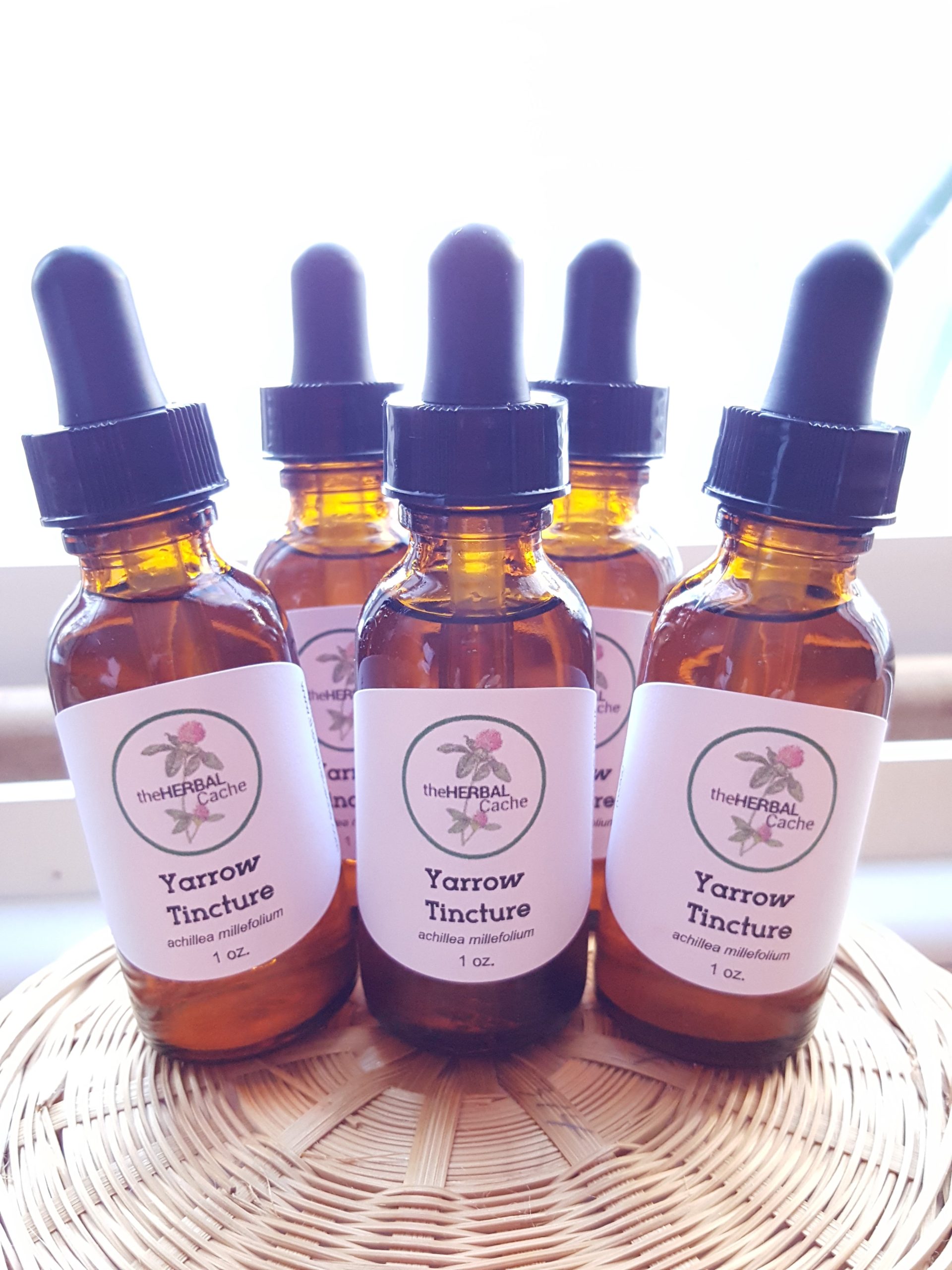
Varicose veins are a common problem, affecting an estimated 25% of the population. While there are many treatments available, including surgery and compression stockings, some people prefer to try natural remedies first. In this blog, I will share 12 blog posts and articles discussing the benefits of using herbs to treat varicose veins and what those herbs are.
Varicose veins are veins that have become enlarged and twisted. They can be painful and unattractive. While varicose veins used to be treated with surgery, there are now a number of non-surgical treatment options available. One popular option is herbal support. Herbs can help to improve the function of the veins, reduce swelling and pain, and promote healing.
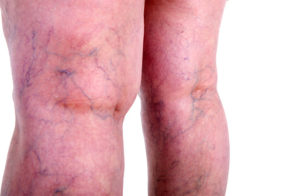
Herbs have been used for centuries to treat a variety of medical conditions, and varicose veins are no exception.
There are many different herbs that can be used to treat varicose veins, each with its own unique set of benefits.
Herbs offer a natural and affordable way to treat varicose veins. Some of the key benefits of using herbs include:
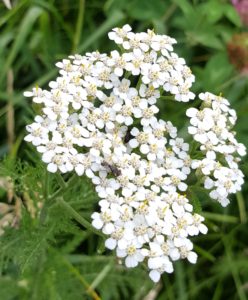
Herbs offer a safe and effective way to treat varicose veins, and I hope this blog post has provided a few ideas for you to start with.
Remember, an herb that works for one person, may not necessarily work for you. Experiment and try them, one at a time to see where you have the best results.
Exercise, diet and sleep also play a role, so don’t forget about them.
I make and sell a natural varicose vein cream that has helped a number of my customers over the years and it is my number one seller.
I grow, forage and wildcraft the yarrow and calendula that I use. The other ingredients I get from reputable sources, such as Mountain Rose Herbs.
If you are ready to combat your varicose veins, you can purchase it HERE.
Here is what one of my customers had to say:
I have to say my expectations were low when I purchased this, because I suffer from spider veins (not varicose veins) and based on my research, the only remedy was sclerotherapy, a costly procedure. I bought 2 small jars (at a great price btw) with nothing to lose. The first couple of weeks, I did not think it was working. Some days the spider veins looked a little faded, other days, unchanged. About 3-4 weeks into applying the cream 2x a day, my spider veins are nearly INVISIBLE!!! I’m genuinely mind blown. I feel so great knowing I won’t be self conscious wearing short shorts and exposing my spider vein-free thunder thighs to the world. About to purchase some more because I don’t wanna run out of this stuff. A 2 oz jar lasted me 4-5 weeks of 2x day application. If you have spider veins, definitely give this a try!
Gardening is such a relaxing and fun activity, and the whole family can join in. The best thing about gardening is that you get to reap the food benefits at the end!
If you’re interested in having a medicinal garden that is low-maintenance, there are certain things you should keep in mind to make it succeed. This includes when to plant, what plants to choose and where to put them. So be prepared to do a little research for your area.
Also, with all the chaos going on in today’s world, now is the perfect time to grow your own and not have to rely on others. Especially with the prediction of shortages looming over our heads.
Medicinal gardens provide many benefits. Not only do they look beautiful, but they can also be used to create natural remedies and food.
And don’t worry about space. Even if all you have is a balcony or small patio, you can utilize pots to grow your herbs in.
Don’t take on too much at the beginning. If you are new to gardening, maybe start with 1-4 plants and see how you do, and how the plants do. The last thing you want to do id overwork yourself and get frustrated and quit.
If you’re interested in starting your own medicinal garden, keep on reading for everything you need to know.
“The kiss of the sun for pardon,
The song of the birds for mirth
One is nearer God’s Heart in a garden
Than anywhere else on Earth.”
Many people enjoy planting medicinal herbs and other medicinal plants. The benefits of these plants have been known for centuries, and they continue to be used by many cultures around the world.
While the exact time to start planting will vary depending on the plant and the climate, there are a few general guidelines that can be followed. For most medicinal plants, it is best to start planting in early spring. This gives the plant time to become established before the hot summer months. However, some plants, such as lavender, do better if they are planted in late summer or early fall.
Think about how you want to start out. Do you want to try growing your herbs from seed or buy seedlings? Some herbs are very hard to start with seeds, so research before buying.
Many herbs are perennials, meaning they will come up every year, so once you get them started, you won’t have to replant them. One less thing to do next year!
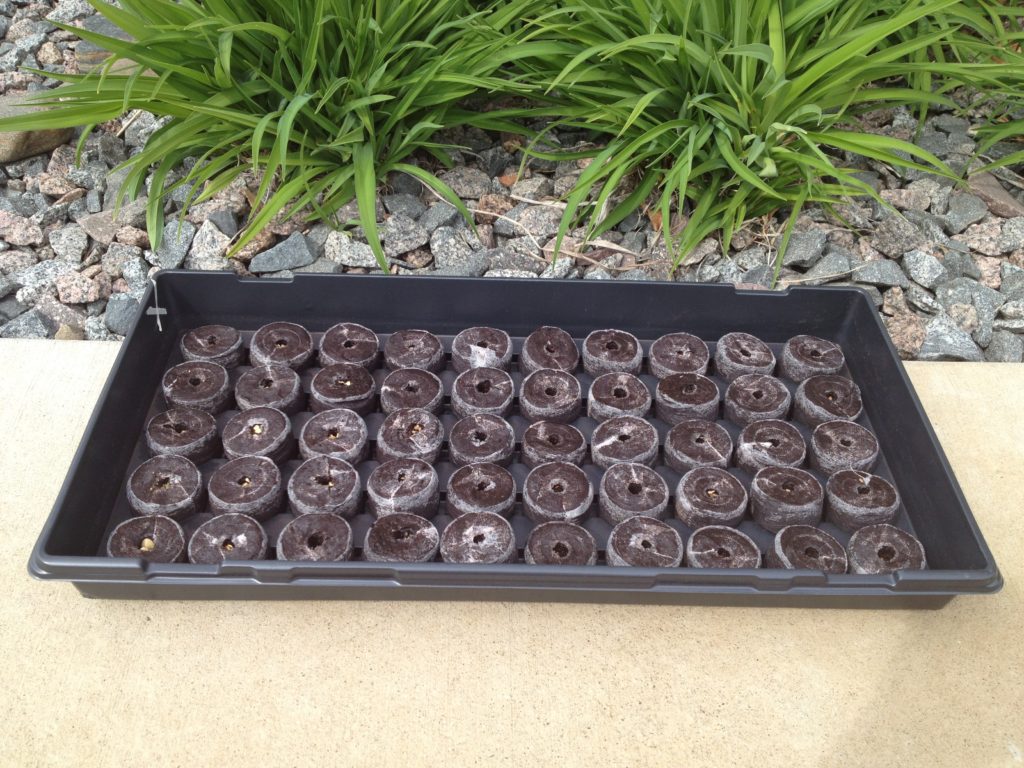
When it comes to medicinal plants, there are a variety of different options to choose from.
Some popular choices include herbs such as basil, rosemary, and mint. These herbs can be used to add flavor to food or brew tea. Other medicinal plants include echinacea, which is used to boost the immune system, and ginkgo biloba, which is often taken as a supplement to improve cognitive function.
Determine what and how you plan to use the herbs. Do you want to just use them in cooking? Than look into planting culinary herbs, such as thyme and sage. If you plan on using them for strictly medicinal purposes, what medicinal issues? If you have skin issues, you may want to plant calendula, which is wonderful for healing wounds, rashes, burns, and dry skin.
No matter what medicinal plants you choose to grow, it is important to research how to care for them properly. Make sure you know how much sun, water and space they will need, as well as any other special requirements.
With a little bit of care, your medicinal garden will grow and produce healthy plants.
Excited about the idea of growing your own medicinal plants and herbs, but not sure where to start? If you’re looking for a spot that is low maintenance and will allow your plants to thrive, here are a few ideas to get you started.
One option is to create a medicinal garden in containers. This can be an easy way to get started, and it gives you the flexibility to move your plants around if necessary. Make sure to choose containers that are large enough for the roots of your plants, and place them in an area that gets plenty of sunlight. You’ll also want to be sure to water your plants regularly, as they can dry out quickly in containers.
Another option is to plant your medicinal garden directly in the ground. If you choose this option, make sure to pick an area of your yard that gets plenty of sunlight and has well-draining soil. To prepare the soil, mix in some compost or other organic matter to help the plants thrive. Once you’ve chosen a spot and prepared the soil, you can start planting your medicinal garden.
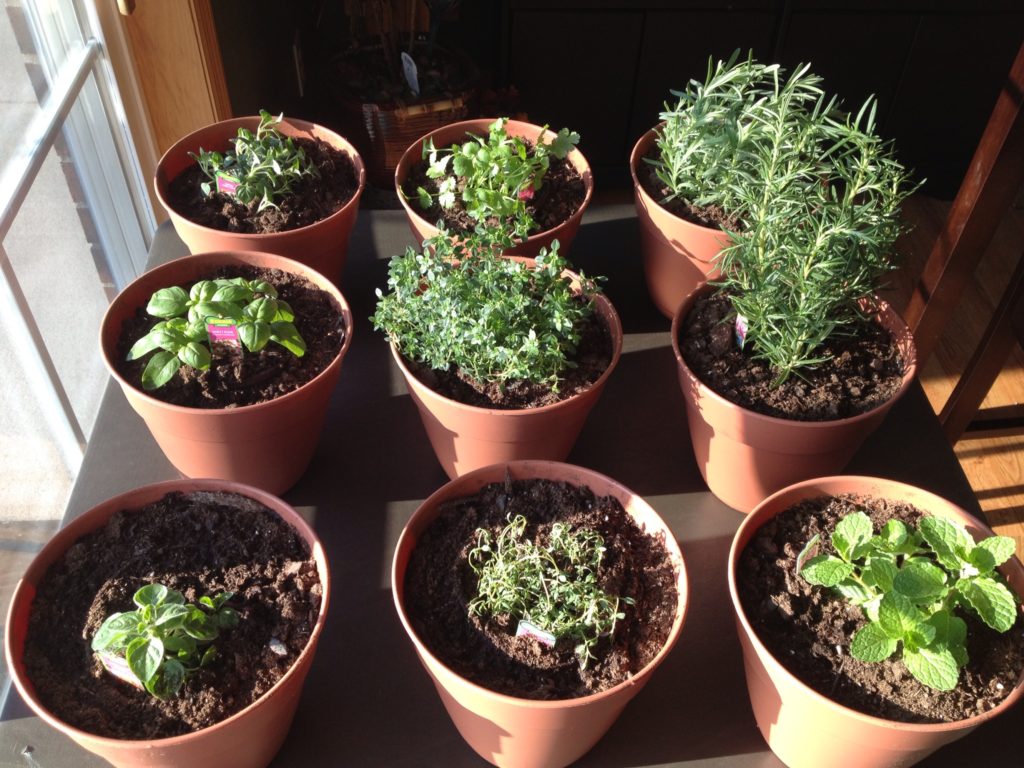
When it comes to medicinal plants and herbs, there are a few things you can do to ensure they thrive in their environment.
First, make sure they have plenty of sunlight. Most medicinal plants and herbs need at least 6-8 hours of direct sunlight each day. Secondly, water them regularly. Allow the soil to dry out slightly between watering, but don’t let the plants get too dehydrated. Third, make sure they’re in a location with good air circulation. Avoid placing them in overly humid or damp areas, as this can lead to fungal growth. Finally, don’t forget to fertilize your plants every few weeks. This will help them to continue growing strong and healthy.
Don’t get upset if a herb or two die on you. Depending on the time of year, you can always plant it again. I love a quote by the Farmstead Lady: “Well, that’s why God invented next year”! Don’t give up on the first try.
If you stay on top of it, you can help your medicinal plants and herbs stay healthy and thrive.
While many medicinal plants are herbs, there are also medicinal flowers and trees.
If you’re looking to add more medicinal plants to your garden, there are a few things to consider. First, what do you want to use the medicinal plants for? There are many different types of medicinal plants, each with their own unique properties. Do some research to find out which plants would be best suited for your needs. Second, consider which plants would be low maintenance. Some medicinal plants can be quite finicky, so it’s important to choose ones that will be easy to care for. Finally, think about how you can add variety to your garden. Maybe you could add some herbs or flowers that can also be used medicinally.
If you’re interested in adding more variety to your medicinal garden, consider some of the following low-maintenance options.
One easy-to-grow medicinal plant is lavender. Lavender has a long history of use as a medicinal herb, and it can be used fresh or dried. Lavender is most commonly used to ease anxiety and promote relaxation, but it can also be helpful for headaches, insomnia, and stomach upset.
Chamomile is another easy-to-grow medicinal plant. Chamomile tea is well-known for its ability to soothe nerves and promote sleep. Chamomile can also be used as a topical treatment for skin conditions like eczema and psoriasis.
Rosemary is a versatile medicinal herb that can be used in cooking or taken as a supplement. Rosemary is thought to improve memory and concentration, and it has also been traditionally used to treat stomach upset and headaches.
Mint is a refreshing medicinal plant that can be used in teas, salads, or as a garnish. Mint is known for its ability to soothe an upset stomach, but it can also be helpful for respiratory problems and headaches. One thing to keep in mind with any member of the mint family, is that they will take over ground space. If this is an issue, consider planting mint in a pot.
Spiraea Herbs has a wonderful video showing some perennial herbs that you can add to your garden.
These are just a few of the many medicinal plants and herbs that you can grow in your garden. By adding a few of these low-maintenance options, you can create a medicinal garden that is both beautiful and functional.
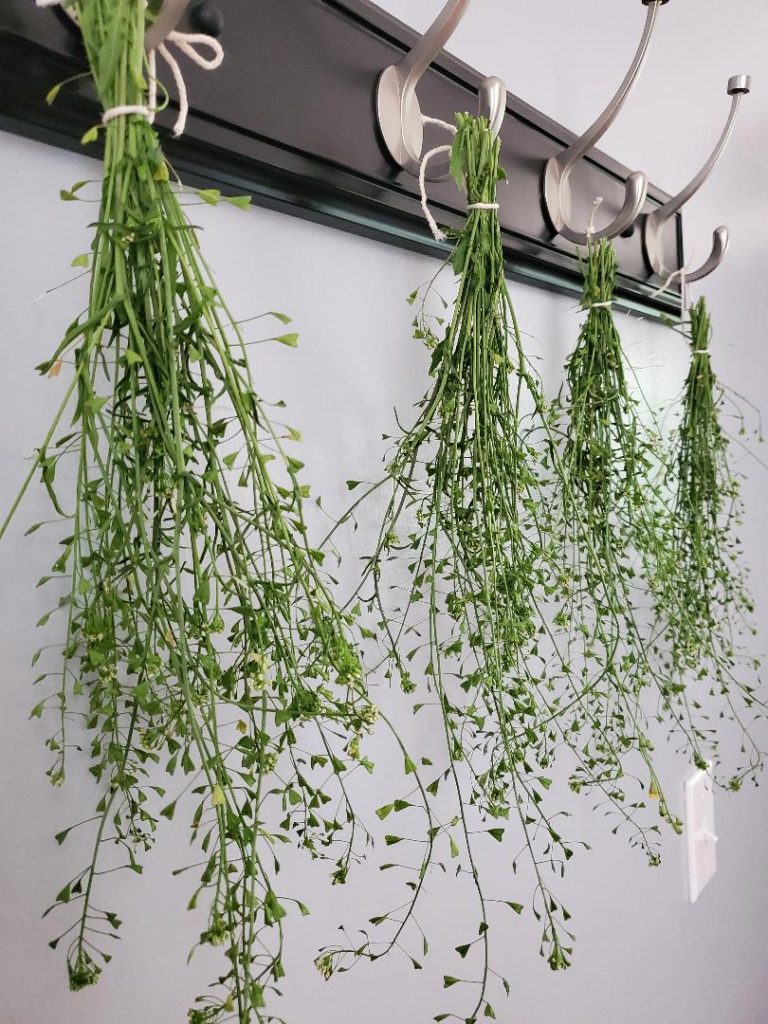
When it comes to medicinal plants, it’s important to know when to harvest them and how to store them properly. Otherwise, they may lose their potency or go bad before you have a chance to use them. Here are a few tips to help you get the most out of your medicinal plants:
With these tips, you can ensure that your medicinal plants are fresh and potent when you need them.
I hope this has inspired you to either start or add medicinal herbs to your garden.
There are many different types of medicinal plants, each with their own unique properties. Do some research to find out which plants would be best suited for your needs.
Second, consider which plants would be low maintenance and survive in your neck of the woods. Some medicinal plants can be quite finicky, so it’s important to choose ones that will be easy to care for. A plant that is easy to grow in California, may need a lot of attention in Minnesota.
Finally, take some time to learn about harvesting and storing medicinal plants. By following these tips, you can create a medicinal garden that is both beautiful and functional.
What medicinal herb are you going to plant?
Garden Lover
Here is a fun video to help get you in the mood!
Elderberries have been all the craze for some time. People make syrup, jam, tea and more with these berries.
What I found out in researching elderberries, was that these berries are very special. They are like the secret remedy for colds and the flu!
There are a few types of elderberry plants, but the black elderberry, Sambucus canadensis, is favored. Because of its strong anti-viral properties, it a huge defender against colds and the flu. Thus the reason for being so popular in the fall.
The world is a nettle; disturb it, it stings. Grasp it firmly, it stings not.
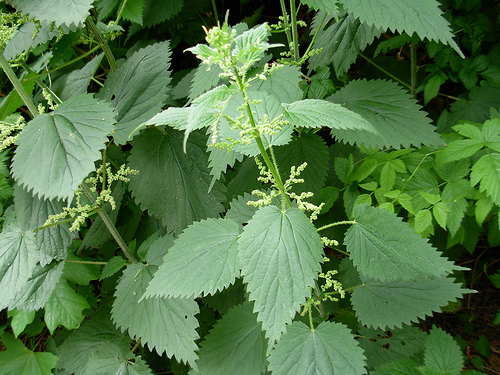
Stinging nettle has been used for centuries to treat various maladies, including anemia, arthritis and skin diseases. Its leaves are edible in salads or cooked like spinach.
And yet many people see it as a weed and want to pull it up by its roots to eradicate it.
But the benefits of stinging nettle include supporting urination, increasing blood flow and reducing neural inflammation.
Let me show you that this plant is more than just a weed.
Stinging nettle is generally considered a weed and can be found growing wild in woodlands and on river banks. It also prefers disturbed soils, such as on farmsteads, manure piles or near abandoned buildings.
Stinging nettles have long fleshy roots that can grow deep into the ground. This is important, because this is how the plant becomes so nutritious, by pulling up vitamins and minerals deep in the soil.
The leaves, stems and roots are covered in tiny hairs that release histamine and other chemicals that can sting painfully. These chemicals cause an itchy, irritating sensation on the skin which only lasts about 15 minutes.
Growing up, my mother called this plant “itch weed”, because it made you itch. So I highly recommended that you wear gloves when handling this plant. Or if you want to get the true feeling of stinging nettle, don’t.
This plant is a very fast grower and spreads easily by seed or underground shoots.
For optimal nutrition and medicinal properties, it should be picked before flowers appear. I like to harvest the tops in early spring when the plants are still young. They will grow back, so you can get a number of pickings.
Susun Weed says to grasp it by a top leaf and cut just the very top (no more than 8 leaves) and put that in the foraging basket. Since nettles are so fibrous, she says to only pick the very tops. If the scissors have difficulty cutting, it’s too far down.
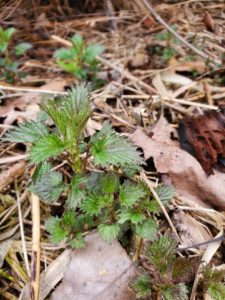
The leaves and young shoots of stinging nettle are edible. They have a slightly bitter, nutty flavor that most find pleasant. Nettle leaves can be a simple substitute for spinach in any dish.
Nettles are rich in vitamins A, C, D and K as well as iron, potassium, calcium and manganese.
One serving of stinging nettle provides almost all of the recommended daily allowance for vitamin K per day.
Nettles are also rich in chlorophyll, which gives them their green color and may be responsible for some of its health benefits.
Two studies published in the “Journal of Agricultural and Food Chemistry” evaluated the antioxidant activity of nettle extract and found it to be higher than other popular drinks like cranberry juice, grape juice and green tea. The researchers concluded that the high antioxidant activity may be due to nettle’s chlorophyll content.
The leaves are said to have a beneficial effect on the urinary system because they contain high amounts of potassium, calcium and magnesium. They also can help reduce inflammation in the bladder lining which may prevent chronic infections from developing.
In addition to its nutritional value, some studies suggest that stinging nettle may also have medicinal properties.
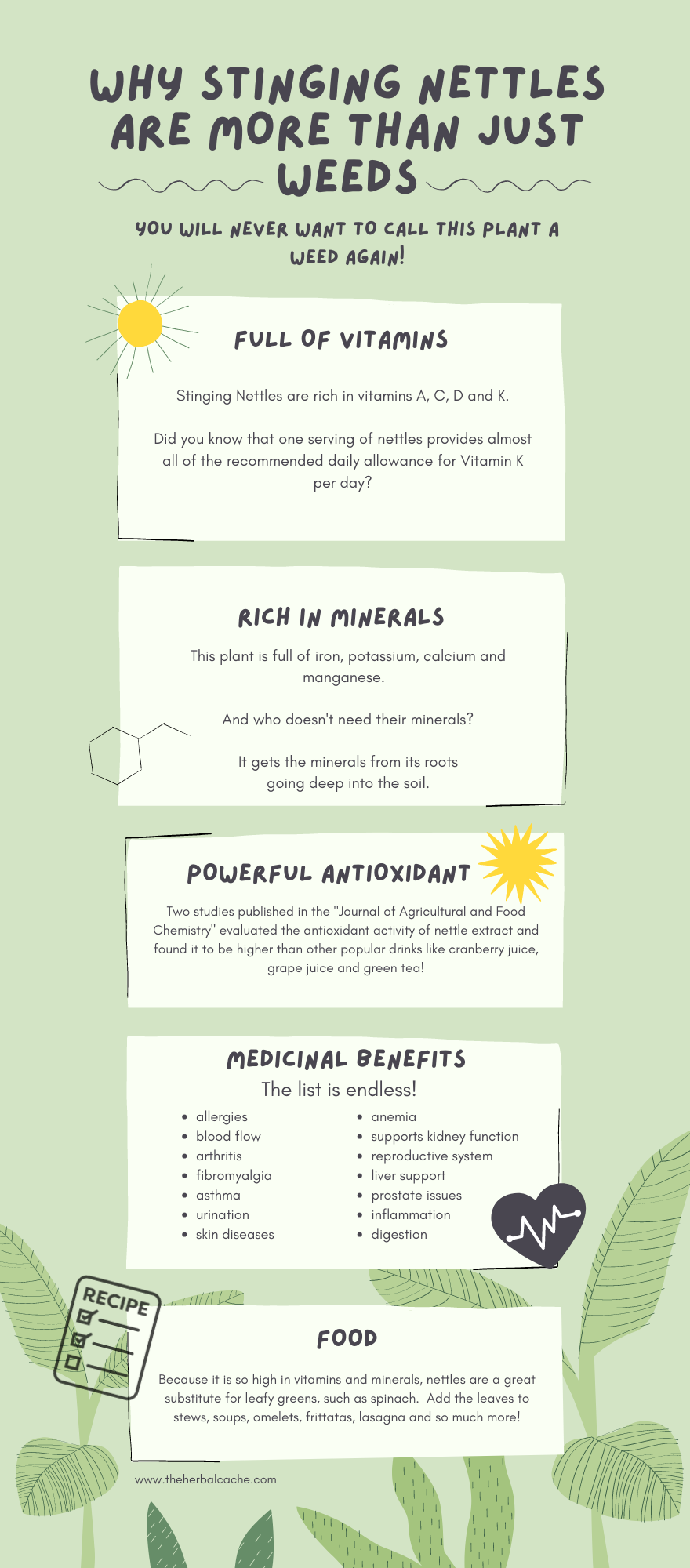
In addition to its nutritional content, stinging nettle is said to have medicinal properties. Its roots and leaves are used in traditional herbal remedies for conditions such as anemia, arthritis and skin diseases. In addition, modern uses include supporting urination and increasing blood flow. Nettle root may also help relieve symptoms of the common cold.
One small study published in the “Journal of Complementary and Alternative Medicine” found that patients who suffered from frequent colds showed a significant decrease in number of colds after taking nettle root extract daily for 12 weeks. These results were not found with the placebo group.
Another study conducted by researchers at the University of Virginia found that drinking stinging nettle tea reduced the total number of colds by more than one-third among patients who suffered from chronic respiratory infections.
Brigitte Mars talks about how people have used nettles for thousands of years to help with pain from arthritis, fibromyalgia and as an early substitute for Viagra! By gently brushing a stem of leaves over one’s skin, the irritation causes a huge blood flow to the area (called irtication). Thus helping with pain, inflammation, etc.
Nettle is a wonderful herb for those with allergies. A study published in “Alternative Therapies in Health and Medicine” suggested that an extract from this plant may reduce inflammatory responses due to allergies, which suggests it may be effective in relieving symptoms of allergies and asthma.
Herbalist Matthew Wood says the seeds in particular, may help get rid of allergies, both food allergies and seasonal ones. He also recommends the root be taken for prostate problems.
Stinging nettle also helps get rid of mucus in the lungs.
David Hoffman calls this plant the “ultimate green tonic”. That should tell you something.
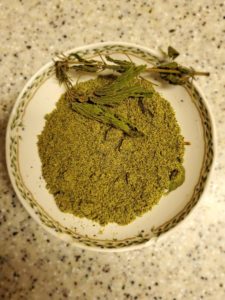
There are a number of ways you can incorporate stinging nettle into your diet.
A very easy way is to cook it like spinach or added to soups and stews for extra nutritional benefit. Herbalist Rosemary Gladstar likes to saute it with a little olive oil, lemon juice and feta cheese.
Herbal Revolution preserves their nettles like this to to enjoy all year:
These little “patties” can be added to soup, pesto, sautéed, in frittata, scrambled eggs, smoothies, etc. This could also be done with dandelion greens!
The young shoots may also be eaten fresh or steamed. But make sure to get the tops of young plants. Nettles are very fibrous in older plants and growth near the ground.
To make stinging nettle tea, steep one teaspoon of dried herb for eight to 10 minutes in hot water. This makes an excellent substitute for coffee that is high in antioxidants and many other nutrients.
People who suffer from chronic conditions like allergies and arthritis may find relief by drinking stinging nettle tea.
Taking nettle in a tincture form is available if you can’t stomach eating the greens, or don’t like drinking teas. As a tincture, it is a more concentrated and you can take it as needed. You can find tinctures in most natural food or wellness stores.
Making a herbal decoction with nettles is another great way to take this plant. Just follow these simple instructions:
My favorite way to use nettles is by making Nettle Gomasio! This herbal spice blend can be used on almost everything. I personally like it on my fried eggs and popcorn.
In the video below, I show you just how easy it is to make your own Nettle Gomasio!
I hope I have shown you just how beneficial stinging nettles are for us.
Not only are they nutritious in terms of the vitamins and minerals they provide, but they also help support our health and body in a number of ways.
Nettles have been around for thousands of years, and I hope they will be around for a thousand more. Because we need them.
So go and “nettle” up!

“An anthology is like all the plums and orange peel picked out a cake.” Walter Raleigh
Eat orange peels?
Now most of us will drink orange juice or eat the inside slices of an orange. But the peel? Too bitter!
But before tossing that orange peel into the garbage, continue reading and be amazed!
The peel has so much to offer us in terms of medicinal properties and keeping us healthy. It has been used for thousands of years to treat different ailments.
Orange peel contains a large amount of Vitamin C and is a powerful antioxidant.
So lets learn a bit about how orange peel is good for us, make a cup of orange peel coffee, look at ways to get orange peel into your diet, and lastly, check out other ways to use up those orange peels.
In Need of Organic Orange Peels?
You can save the peels from organic oranges you purchased and dry them yourself. Easy peasy.
Or you can purchase them from Mountain Rose Herbs, who stand for organics, fair trade, sustainability and more.
Orange peel, along with other citrus fruits, have been used for thousands of years as medicine.
It contains flavanoids, Vitamins A, C, B5 and B6, calcium, riboflavin, thiamine, niacin, folate and dietary fiber.
Lets look at the 21 ways orange peel has been used over the years to help with overall health and how you can benefit.
1. Diarrhea
2. Indigestion
3. Constipation
4. Cleansing
In Traditional Chinese Medicine (TCM), the orange peel has been used for hundreds of years to help with gas, bloating and other digestive issues.
The orange peel contains pectin, which is a beneficial carbohydrate that the good bacteria in your gut feed off of.
5. Colds
6. Coughs
Because of its antibacterial, antifungal and antiviral properties, orange peel is a great for warding off cough and colds. It helps in getting excess phlegm out of the lungs.
7. Weight Loss
8. Obesity
9. Athletic Performance
A team of scientists in Taiwan researced the effects of four different orange peel varities, and found that they remarkably reduced the production and accumulation of triglycerides in fat cells.
10. Cholesterol
When taking in large amounts of orange and orange peel, the HDL increases, while the LDL decreases, which is great for those with high cholesterol.
11. High Blood Pressure
The potassium in orange peel plays a huge role in lowering the risk of high blood pressure.
12. Anxiety
13. Stress
14. Hypertension
15. Depression
Studies are now showing that by just inhaling the aroma of orange and orange peel, can have an uplifting effect on people.
16. Arthritis
17. Rheumatism
Orange peel contains powerful anti-inflammatory agents that help with swelling, redness and inflammation.
18. Asthma
19. Oral Health
20. Hangovers
21. Poor Circulation
So how can you get more orange peel into your diet? Let’s start with a cup of Orange Peel Coffee and then look at more ways to use those peels.
This coffee recipe is not only easy to make, but so good to drink!
Coffee has always been associated with caffeine and a morning pick-me-up. This cup of freshness is much more.
Smelling the citrus aroma while the orange peel is steeping in the hot coffee is just up-lifting.
Are you ready for some?
Here is the recipe for Orange Peel Coffee. I’ve taken it from HERE and adapted it to my tastings. That’s what makes this recipe so wonderful! You can adjust it to your likings.
Orange Peel Coffee
Ingredients:
Directions:
Enjoy my fun little video below on making Orange Peel Coffee!
Besides eating orange peel, there are a number of other uses for orange peel, so don’t throw it out! Unless it’s into the compost pile.
Here is a list of uses:
https://www.motherearthliving.com/cooking-methods/citrus-peel-medicine-coffee
https://www.webmd.com/vitamins/ai/ingredientmono-908/sweet-orange
https://www.motherearthliving.com/health-and-wellness/citrus-peel-medicine
https://www.linkedin.com/pulse/25-proven-health-benefits-orange-peel-tea-dr-paul-haider/
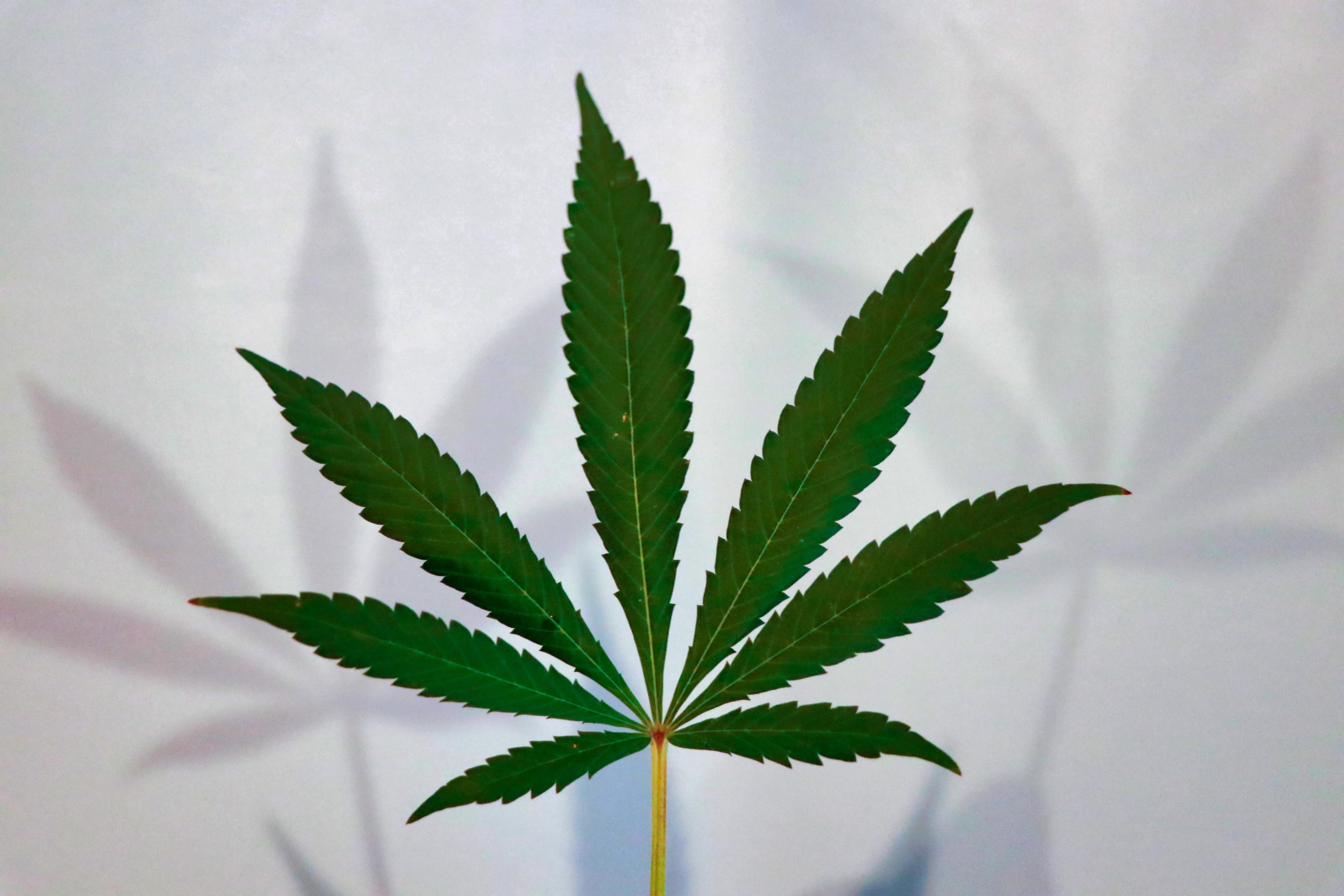
“What is a weed? A plant whose virtues have not yet been discovered.” Ralph Waldo Emerson
I thought there were probably only a few people out there that haven’t heard of CBD. Because friends and neighbors talk about it, it is advertised on the television, you can find it in natural retail stores and even at gas stations!
And it comes in all kinds of forms: liquid extracts, capsules, gummies, balms, ointments, lotions, bath bombs and even shampoo!
It’s like the new best thing!
But a recent Gallup poll showed that only 64% of US adults know about CBD.
Working in a retail store in the supplement and body care department, I deal first hand with customers looking for CBD. It is very interesting to listen to them as to what they have heard or read about it. There is a lot of misconceptions about CBD and some people don’t understand it. Some think it is marijuana. Yikes!
CBD doesn’t get you high, it gets you healthy.
So sit back and let me share with you some of the CBD basics I tell my customers at the brick and mortar store and if it may be beneficial for you. Because CBD is not for everyone.
CBD is the acronym for cannabidiol.
Canna what?
That is why we just go with CBD. Much easier, right?
CBD comes from the cannabis plant and is only one of over 100 phytocannabinoids (phyto meaning plant) that have been identified up to now.
THC, another phytocannabinoid in cannabis, is the one that creates intoxicating effects. CBD does not. So you can NOT get high from taking CBD.
In relation to all of this, you may have heard the term hemp. So you may be asking yourself, how do all of these differentiate?
Let’s take a look.
First we have the genus Cannabis.
Cannabis is then broken into two species, hemp (CBD) and marijuana.
The infographic below shows the entire tree lineage for cannabis.
Fun Fact: Hops is in the Cannabaceae Family!
In talking to customers, I compare apples to show the difference. We have apples, many varieties of apples, but they are all still apples. Same with cannabis.
The term hemp is used to differentiate the two species of cannabis because it has 0.3% or less of THC.
I will have a customer here and there ask for hemp oil, when they are really looking for CBD oil. Hemp oil is derived from the seed of the cannabis plant and contains no CBD or THC.
CBD works on the endocannabinoid system, which was only discovered 25 years ago, so it is still fairly new in the field of science. It works on the receptors throughout the body to help keep the endocannabinoid system in balance.
The endocannabinoid system receptors are responsible for managing a variety of different things, including appetite, mood, energy, and much more.
Our body naturally synthesizes what are called endogenous cannabinoids, which are chemical messengers that interact with these receptors. CBD, a phytocannabinoid, interacts the same way.
So all in all, receptors in our nervous system and immune system react to cannabis compounds and produce specific effects that may benefit many bodily processes.
Fun Fact: Cannabis is one of the oldest medicinal plants used by humans!
According to the Gallup Poll mentioned earlier, 14% of Americans use CBD products. What they take it for is as follows:
This coincides with what I see at my workplace. Most people are looking for help with pain.
Hemp is hope, not dope
Remember, CBD does not cure any disease, it is just a way to help the body feel better.
When looking for CBD, you’ll see that it is available in almost any form you can think of.
CBD comes in a number of edible forms, such as liquid extract, oils, capsules, gummies, etc. Some people don’t want to take another pill, so they opt for the extract or gummy. Others are worried about the taste and will go for the pill to avoid tasting the hemp. And yes, some of the extracts and gummies come in flavors, such as peppermint or cherry, but all the ones I’ve tasted do give me an aftertaste of hemp. I don’t mind the taste, but a number of people do mind it.
Me taking a CBD gummy!
The liquid oils are usually the most potent and unprocessed form. Also, it is the easiest way to control your dosage.
CBD also comes in a number of topical forms. You can find balms, ointments, lotions and even bath salts! These are nice for those who don’t want to ingest anything. And it can be applies right where you want it, like on arthritic hands.
Everyone reacts differently to CBD. And you need to find a dosage that works for you. CBD is not a one-size-fits-all.
Will it work?
I tell my customers that CBD doesn’t know what you are taking it for. You may want it for pain, but it helps you sleep much better. CBD just goes in and does its thing. I ask customers to pay attention to any and all suttle changes that may occur when taking CBD.
Also, some people will notice changes quickly, while others may take hours, days or even weeks to feel a difference.
And more is not always better. Some people think they need to take a high dosage right off the bat. NO! All experts I’ve spoken too say to start with a low dosage and work your way up till you find that it works for you. There are a number of reasons for this.
First, if you take too much CBD, it may do nothing at all. I had a customer tell me she was taking a smaller dosage for some time that worked for her. She then wanted to try a higher dosage. She did and nothing happened. She went back to her lower dosage and it started working again.
Second, if you take to much, you could have some side effects such as upset stomach, nausea, headaches or dizziness. That is your body saying you took way too much CBD for your system.
So far, it does not look like one can build up a “tolarence” for CBD.
According to Junella Chin, DO, an osteopathic physician and a medical cannabis expert for cannabisMD, about 5% of people say they feel altered after taking CBD. She says these are usually the same people who have side effects when taking Advil or Tylenol.
But with all that, most of the customers I talk to say CBD has helped them in some way, whether for pain, sleep, anxiety, etc. I even had one elderly lady say she didn’t know if it was just in her head, or if it really took away the pain, but she was going to keep taking it either way because she felt better.
Make sure when shopping for CBD to that it is third-party tested for quality assurance. Because CBD is not regulated by the FDA, it may not be exactly what the label says. The 2017 Journal of the American Medical Association study, for example, which tested 84 CBD products, found that 26% contained lower doses than what was stated on the label.
Keep in mind, if you take CBD, it could show up on a drug test.
There are a lot of CBD brands out there, so where do you start?
First, make sure the brand you are looking at is third-party tested. That way you know you are getting what is listed on the label.
Second, research the brand or brands. Have they been working with CBD for years or did they just get on the band wagon? What is their mission statement? What do they stand for?
Third, don’t just look at the price. There are some brands out there that are more expensive, but you are paying for their marketing and packaging. Research the company.
Lastly, compare apples to apples. Some of the brands will list serving size according to CBD content, while others use hemp. And with liquids, the amount listed on the front of the bottle is usually for the entire bottle, not a single serving. So make sure you are comparing like to like.
My go-to brand is CV Sciences (also know as PlusCBD) for many reasons.
I take it to help me get a good nights rest. It helps to calm me down after a busy day. I don’t take it everyday, just when I feel I need it.
You can find out more about CV Sciences and ordering CBD HERE.
As with any supplement, before taking research it. Know what it does, how it affects people, etc. You know yourself more then anyone, so you decide what you need to live a more happy and painfree life.
https://www.health.com/condition/pain/what-is-cbd
https://www.healthline.com/health/hemp-vs-marijuana#legality
https://draxe.com/nutrition/what-is-cbd-cannabidiol/
https://news.gallup.com/poll/263147/americans-say-cbd-products.aspx
https://www.sciencedirect.com/science/article/pii/B9780128007563000016
https://www.beautyarmy.com/lifestyle/to-understand-the-misunderstood-15-great-quotes-about-cbd-oil/
**Some links in this article may be affiliate links.